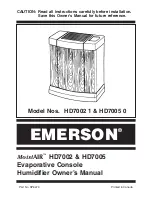
Operating manual – Dehumidifier TTR 200/300
B-4
EN(UK)
Optional accessories
For operation of the dehumidifier, the following accessories are available:
Hose adapter for installation at the intake cover (7)
Air filter box with tube/hose port for Z line filter G4 to F9
Drying air diffuser, triple
Hygrostat with Tuchel plug for connection socket (6)
Combined meter for operating hours and energy consumption (only
TTR 300)
For the technical data and order conditions, please contact the Trotec
customer service.
8. Set-up and commissioning
Set-up
a) Inside the room to be dehumidified:
The device works with air circulation. The regeneration exhaust air is to
be released outside. This proportion must be balanced by supplying fresh
air into the room.
b) Outside the room to be dehumidified:
The device can be connected in air circulation or through-air operation
mode. In this respect, connection must be established between the dry-
ing air and the room to be dehumidified. Also here applies: In air circula-
tion operation, the proportion of regeneration air must be balanced with
fresh air.
Installation
The pipelines or hoses must be designed for the applied static pres-
sure by the fans. Air hoses are to be laid out in a straight line and
outstretched.
The regeneration exhaust air line must be laid out with a slight slope
to prevent potential condense water from flowing back into the de-
vice or disturbing the air flow. If the air line is to be laid out in a ris-
ing direction, a discharge is to be provided for condense water. As a
precautionary measure, the exhaust tube can be insulated.
To prevent an air short circuit with the humid exhaust air, the humid
air outlet of free-intake devices is to be laid away at a minimum
distance of approx. 1.0 m from the device.
Presettings
Ventilation devices are generally equipped with one or several fans with
sufficient dimensions to overcome resistance in potential pipelines or
appliances. In most cases, their speed cannot be adjusted. To set the
required air flow for the respective application, the hydraulic adjustment
is to be carried out by means of throttle valves installed downstream and
upstream of the fan. However, this leads to an unnecessary and often
considerable increase in noise and energy consumption.
This device is equipped with a
variable-speed high performance fan
to
supply the nominal drying and regeneration air flows at maximum speed
with connected air hoses (each approx. 6 m long).
Additionally, the device features a heating unit generating heat by means
of ceramic PTC semiconductor components to heat the regeneration air.
These elements generate and keep a maximum surface temperature of
approx. 240 °C. The temperature-dependent resistance, which increases
quickly with decreasing heat distribution under a certain value (Curie
temperature), leads to a self-regulating effect of the heating power con-
sumption, i.e. in case of an increase in air temperature and/or decrease
in air volume, the power consumption decreases (and vice versa). Ad-
ditionally, destruction of the device by overheating, e.g. due to a lack in
regeneration air, can be excluded.
Due to its design, the device is only equipped with one fan for both flows.
For this reason, the speed adjustment of the fan may not be sufficient.
In this case, additional measures must be taken to fine-tune the flows in
the tube/hose lines.
To achieve
minimum humidity outlet
at minimum drying air or
maxi-
mum dehumidification performance
at maximum drying air, it is cru-
cial to appropriately adjust the volume of regeneration air. The air volume
must be adjusted until the value defined as
optimum heating flow
is
displayed at the ampere meter.
For all other applications with low requirements placed on the dehumidi-
fication performance and drying air volume, the speed of the fan can be
reduced until the value defined as
minimum heating flow
is displayed
at the ampere meter. This way, very good dehumidification results can be
achieved at minimum energy consumption.
9. Operation
Switching the device on
The device can be switched on at the power switch (4). The integrated
control indicator will light up.
Switching the device off
The device can be switched off at the power switch (4). The integrated
control indicator will go out.
Remote operation
The device can be switched on at the power switch (4). The integrated
control indicator will light up.
Use the respective Tuchel plug (optional accessory) to connect an exter-
nal switch or control unit, e.g. hygrostat or timer, to the connection sock-
et. Please strictly follow the information in the attached circuit diagram!
If necessary, all electrical actuators can now be switched on or off by
means of the external switch. The control indicator on the power switch
keeps flashing irrespectively of the switching position and indicates that
the control system is activated.
In hygrostat operation, it may be necessary to provide air circulation at
the humidity detection position. In this case, the fan can be configured for
permanent operation by repositioning a plug at the integrated relay. This
operation may only be performed by a trained electrician. If necessary,
please contact the Trotec customer service.
Air volume adjustment
The fan speed can be adjusted at the speed controller (5). Turn the con-
troller to the right to increase the air volume and to the left to decrease it.
All manuals and user guides at all-guides.com
all-guides.com
















































